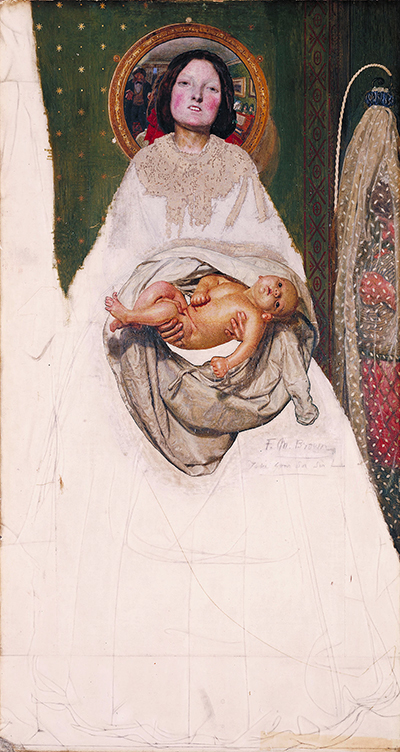This unfinished painting is one of Ford Madox Brown's many compositions that included depictions of his own family and friends. Despite the almost comedic title given to the work, there is a deeply sorrowful reason that the work was abandoned and never returned to.
The painting, mostly white background with details lightly sketched in with charcoal or pencil, shows a woman holding a baby, almost in the classical pose of a Madonna and child. A mirror behind the woman's head gives the superficial impression of a halo, which seems to confirm this impression. However, the completed portion of the painting, which shows the woman's upper body and face, and the whole naked body of the infant, reveals that if this is a nativity scene, it is one with a difference.
The woman seems to be offering the child to the painter – who can be seen in the mirror behind her, in the manner of Van Eyck's Arnolfi Portrait – with a rather final expression, as if she was indeed saying the title of the painting: Take your Son, Sir! with the merest hint of threat underlying the plea. Her expression is not merely fed up: she seems completely drained, as though she is using the last of her will to hold her child and any gainsaying of it will result in a tragedy of some kind.
The baby, completely relaxed and trusting, is naked – at his most vulnerable – which only adds to the menace of the casualness with which the mother is holding him – one hand gripping a leg, the other a shoulder, with the baby's head laid negligently along her arm. He seems almost alien and incomprehensible: an emotion that many new parents, bewildered with the speed of change to their world, are well versed in.
However, this painting, perhaps intended as a humorous nod to the rigours of birth and new parenthood, or a satirical comment on life and death (the woman's face has the look of a death mask, while the robes surrounding (but not covering) the infant give it the look of being in the womb), has a tragic tale behind it. The woman in the painting is Madox Brown's second wife, Emma, and the baby is their son, Arthur Gabriel. Madox Brown worked on the painting while Emma was pregnant and shortly thereafter, trying to perfect his vision. The baby sadly died at just ten months old, and Madox Brown lost heart, finding himself unable to finish the painting in his grief, despite making periodic efforts over the next five years or so. The painting, in all its incomplete glory, can be found in the Tate Gallery in London, measuring 38.1 by 70.5 centimetres, and is in oil on canvas.




